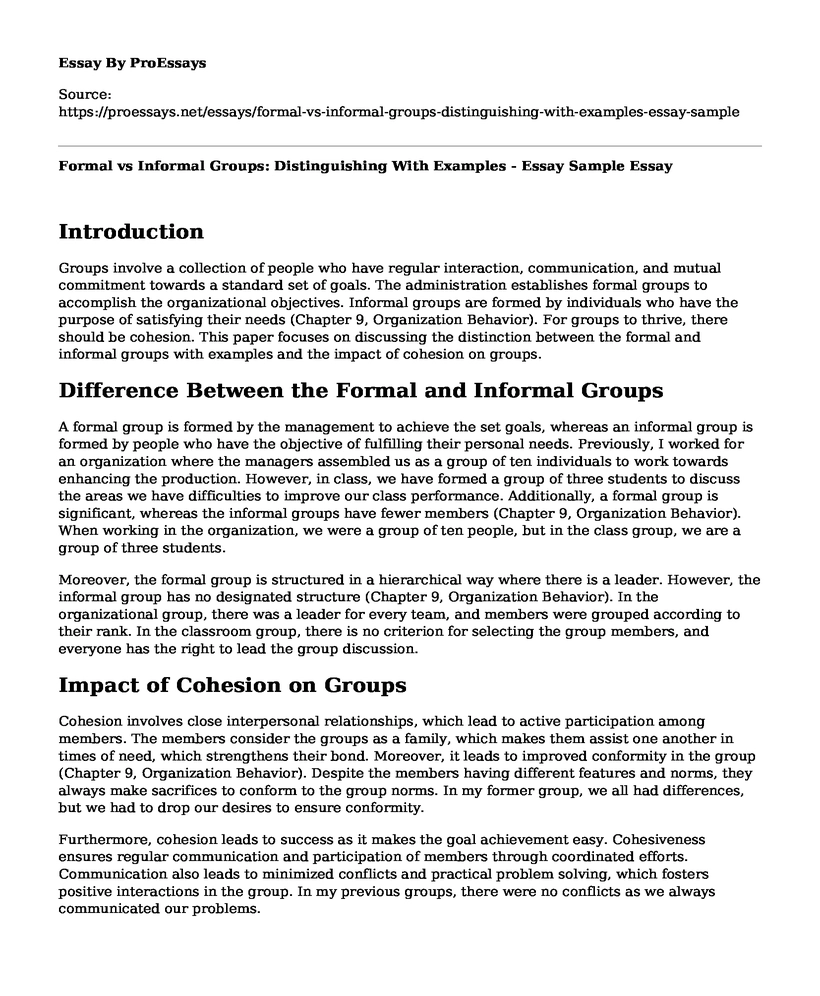Introduction
Groups involve a collection of people who have regular interaction, communication, and mutual commitment towards a standard set of goals. The administration establishes formal groups to accomplish the organizational objectives. Informal groups are formed by individuals who have the purpose of satisfying their needs (Chapter 9, Organization Behavior). For groups to thrive, there should be cohesion. This paper focuses on discussing the distinction between the formal and informal groups with examples and the impact of cohesion on groups.
Difference Between the Formal and Informal Groups
A formal group is formed by the management to achieve the set goals, whereas an informal group is formed by people who have the objective of fulfilling their personal needs. Previously, I worked for an organization where the managers assembled us as a group of ten individuals to work towards enhancing the production. However, in class, we have formed a group of three students to discuss the areas we have difficulties to improve our class performance. Additionally, a formal group is significant, whereas the informal groups have fewer members (Chapter 9, Organization Behavior). When working in the organization, we were a group of ten people, but in the class group, we are a group of three students.
Moreover, the formal group is structured in a hierarchical way where there is a leader. However, the informal group has no designated structure (Chapter 9, Organization Behavior). In the organizational group, there was a leader for every team, and members were grouped according to their rank. In the classroom group, there is no criterion for selecting the group members, and everyone has the right to lead the group discussion.
Impact of Cohesion on Groups
Cohesion involves close interpersonal relationships, which lead to active participation among members. The members consider the groups as a family, which makes them assist one another in times of need, which strengthens their bond. Moreover, it leads to improved conformity in the group (Chapter 9, Organization Behavior). Despite the members having different features and norms, they always make sacrifices to conform to the group norms. In my former group, we all had differences, but we had to drop our desires to ensure conformity.
Furthermore, cohesion leads to success as it makes the goal achievement easy. Cohesiveness ensures regular communication and participation of members through coordinated efforts. Communication also leads to minimized conflicts and practical problem solving, which fosters positive interactions in the group. In my previous groups, there were no conflicts as we always communicated our problems.
Reasons Social Loafing is Unethical
Social loafing is unethical as it involves a group member's tendency to put less effort when working in the group than individually. I have been in a group where individuals used to evade the group responsibilities for others to do them. According to the normative theory, it is wrong to maltreat others. The approach is based on making decisions that help other members of the group maximize the utility of the outcome (Chapter 9, Organization Behavior). Ethically, everyone should do whatever is expected of them. Social loafing also breaks the group's agreement as individuals evade what they have been assigned to do.
Furthermore, the group may divide the responsibilities in a manner that is not equal. Therefore, some members will not be doing their full share of work. Other members would be burdened with a lot of work, which is unfair for them. In normative theory, decisions should not be biased, which makes the group's agreement unethical as some members will be overworked at the expense of others. Some members have additional pressure in the group duties, whereas a group should have equal responsibilities.
Reference
Chapter 9, "Managing Groups and Teams" Organizational Behavior. University of Minnesota Libraries Publishing Edition, 2017. Retrieved from https://www.oercommons.org/courses/organizational-behavior-2
Cite this page
Formal vs Informal Groups: Distinguishing With Examples - Essay Sample. (2023, Mar 04). Retrieved from https://proessays.net/essays/formal-vs-informal-groups-distinguishing-with-examples-essay-sample
If you are the original author of this essay and no longer wish to have it published on the ProEssays website, please click below to request its removal:
- Businesses in the Modern Day Essay Example
- Race and Social Problems Essay Example
- Health Disparities Among Black and Hispanic Populations Essay
- Essay Example on Social Media: Positive & Negative Impacts on Society
- Essay on My Four-and-a-Half-Year-Old Cousin's Remarkable Conversation Skills
- Essay Example on Diaspora Radicalization: Financing, Recruiting, and Training
- Essay on Rise of Divorce: Unveiling the Factors Behind Increased Rate







